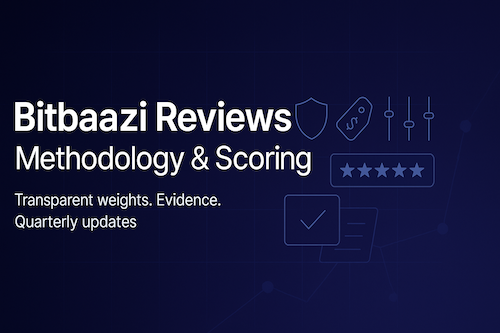Summary
What we review and why it matters.
How we weight security, fees, and UX
The tests we run and how we verify.
When and why scores change.
We publish transparent, testable reviews so readers can compare services with confidence.
What our reviews cover
We focus on user risk and real utility rather than hype or price moves.
Scope includes account creation, KYC/AML flows, custody and keys, security controls, supported assets, liquidity and slippage, fees and spreads, fiat rails, customer support, transparency, and incident response. We align disclosure and independence with the FTC’s Endorsement Guides for reviews and endorsements.
Scoring model & weights
Clear weights show how each factor shapes the final score.
Weights: Security 30%, Fees/Costs 20%, Liquidity/Execution 15%, Asset Support 10%, UX/Accessibility 10%, Transparency/Governance 10%, Support/Resolution 5%. Security checks reference common web‑app risks and control hygiene; transparency looks for audits, proof‑of‑reserves, and governance clarity; UX covers accessibility and friction. For independence and disclosures, see our Editorial Policy which also explains how affiliate relationships are handled.
How we test, verify, and update
We combine hands‑on testing, documentation checks, and policy review.
Testing includes: live deposits/withdrawals on multiple networks, fee and spread capture at common order sizes, slippage on liquid pairs, enabling MFA and device keys, recovery flows, and support tickets. We verify disclosure and independence against applicable guidelines and publish category notes with evidence summaries. Update cadence is quarterly, with out‑of‑cycle updates on material events such as security incidents, fee changes, license actions, delistings, or major outages. All changes are logged with date‑stamped notes.
FAQ
How often do scores change? Quarterly reviews, plus immediate updates for material events.
Why is Security weighted 30%? Security failings can cause total loss, so risk outweighs convenience.
What counts as “fees”? Maker/taker, network, spreads, FX, and hidden conversion or custody fees.
Do affiliate links affect ratings? No—editorial is independent and disclosure rules are applied.
What evidence do you keep? Receipts, hashes, screenshots, and test TXIDs are archived for audit.
■ Takeaways
Trust the method, not hype: weights and evidence are published.
Compare like‑for‑like: normalize costs and slippage by size and pair.
Favor platforms with robust controls and clear disclosures.
Recheck before big actions; platforms can change quickly.
Reviews inform decisions but are not investment advice.
评测范围
我们聚焦用户风险与真实可用性,而非话题热度或价格波动。
范围涵盖开户与 KYC/AML、托管与密钥、安全控制、资产支持、流动性与滑点、费用与价差、法币出入金、客服与纠纷处理、透明度与应急机制;关于独立性与披露的执行细则,参见我们的编辑方针,其中也说明了联盟关系的处理。
评分模型与权重
透明的配分让读者理解每一项如何影响总分。
权重:Security 30%、Fees/Costs 20%、Liquidity/Execution 15%、Asset Support 10%、UX/Accessibility 10%、Transparency/Governance 10%、Support/Resolution 5%。我们参考常见 Web 风险与控制实践评估安全性;透明度关注审计、储备证明与治理清晰度;可用性检查可及性与流程摩擦。
测试、核验与更新
我们结合实测、文档核查与政策背景,输出可复现的结论。
实测包括多网络充提、不同档位下的费用与点差采集、热门交易对的滑点测试、MFA 与设备密钥启用、找回流程以及客服工单验证;同时记录证据要点与分项说明。评测按季更新,重大事件(安全事故、费率调整、牌照处置、下架或重大宕机)即时修订,并保留时间戳变更日志。
レビューの対象
私たちは話題性や価格ではなく、ユーザーのリスクと実用性を評価します。
対象は口座開設と KYC/AML、カストディと鍵、セキュリティ制御、対応資産、流動性とスリッページ、手数料とスプレッド、法定通貨の入出金、サポート、透明性、インシデント対応です。独立性と開示の基準は編集方針に明記し、アフィリエイトの扱いもそこで説明しています。
スコアリングと配点
配点を明確化し、最終評価に至る重み付けを見える化します。
配点:Security 30%、Fees/Costs 20%、Liquidity/Execution 15%、Asset Support 10%、UX/Accessibility 10%、Transparency/Governance 10%、Support/Resolution 5%。セキュリティは一般的な Web リスクとコントロールの健全性を確認し、透明性は監査・準備金証明・ガバナンスの明瞭さを重視、UX はアクセシビリティや手続きの摩擦を点検します。
検証プロセスと更新
実地テスト、ドキュメント確認、制度背景を組み合わせて検証します。
複数ネットワークでの入出金、手数料とスプレッドの採取、主要ペアでのスリッページ測定、MFA・デバイス鍵の有効化、復旧手順、サポート対応を確認し、分野別メモと証跡概要を公開します。四半期ごとに見直し、重大変化(セキュリティ事故、手数料の変更、ライセンス処分、上場廃止や大規模障害)は随時更新し、変更ログを残します。
